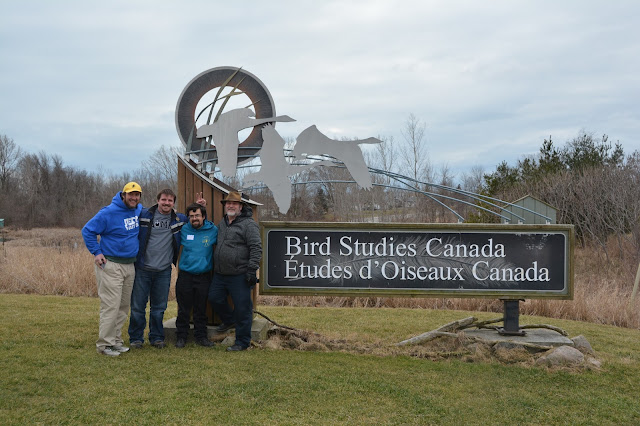 |
| clayton quinton showing a duck nest with two common goldeneye eggs |
Yesterday taking advantage of family day weekend for the third year in a row the Quinton family have taken on the job of cleaning out the duck boxes at the marsh.. That is a job that used to take two days with all of the terra kids on snowshoes and now three snow machines and four people can clean out 40 boxes in four hours.
 |
| Clayton modeling his new kerns public school of flock hat also showing the duck nest as well as a couple of common grackle nests and showing a duck box with the side door open showing how we can access the box to clean it out and put in frsh shavings. it is critical that any kind of bird house must be cleaned out every year. |
It is actually a big job to clean out the boxes and record the data for each box. Each box has to be cleaned out and fresh shavings are put in so the mother ducks find a box that is perfect to lay eggs in. It seems strange that ducks will lay their eggs in hole in a tree commonly referred to as a cavity but there are three species at the marsh that will use a cavity at the marsh. Boxes basically are artificial cavities and have the advantage of being easily cleaned with a side door giving access to the box. In nature a cavity established either by a piliated woodpecker or a limb ripping off a tree establishing a cavity can be hard to find and a few seasons of breeding can fill the cavity with nest materials.

Once they team gets to the boxes they open the box they record what species used the box. Conveniently the three species that use the boxes at the marsh all have different coloured eggs. Common goldeneyes have green eggs, wood ducks have brown eggs and hooded mergansers lay white eggs. The other species that will use the boxes are common grackles and the odd time a sawwhet owl or a kestrel will use the boxes for nesting as well as they are species that also need a cavity to nest.
 |
| Jeff Mercier and Jason Black in the foreground and Curtis and Clayton Quinton Getting ready to head out |
One of the challenges of managing duck boxes at the marsh is that either due to ice movement or bears the boxes sometimes come down and despite having a map of the boxes if a box has been pushed over they can be impossible to find in the winter. The boxes are placed on 10 foot poles that are pushed into the soft marsh bottom about four feet so they are in firm footing. This year the guys took GPS coordinates to help us find them.
 |
| common grackle nest |
This year the marsh summer crew is going to focus on the boxes as we need to erect at least another 20 boxes as well as performing some maintenance on the boxes. The nice part is that the crew begins at the marsh after the chicks have left the nests so the timing will be perfect. The challenge as well for us at the marsh is that the poles and the hardware for the boxes are not cheap and we need to fund raise for these items or reach out for donations to get this important work done. The keen issue here is something called egg dumping. For some reason if there are not enough boxes female ducks will sneak into another hens nest and will lay her eggs on another nest. Sometimes we will find nests that have over 16 eggs in it which are impossible for the original hen to incubate so the eggs die. Sometimes we even find eggs from all three species in one nest!! The solution is to add more boxes which is our plan. If anyone knows someone that has some 10 foot poles that they might donate to the marsh please let us know as that would be a huge help in our efforts to help in duck conservation at the marsh.
 |
| Blast from the past 2005 kids on snowshoes helping clean out boxes. Guess that should have said kids from 2005 did not mean to infer we had 2005 kids helping. |
If anyone would like to come and help out this summer as we put up boxes please get in touch the more the merrier. As well the guys tell me that they love checking the boxes and it is a great family outing. I am sure Curtis would welcome some help so if there is someone out there with snow machines that would enjoy helping please get in touch and we will get you busy next year. Until then it is always a serene feeling for me knowing that the boxes have been prepared and are waiting for the ducks to return not only to the perfect wetland habitat but to a habitat that also has the cavities that they so desperately need to breed So a big thank you to Curtis Quinton and his team for providing the
wood ducks,the
common goldeneyes, and
hooded mergansers with clean boxes. Let the migration begin!!! The sad news is we have to wait almost 2 more months for the marsh to be open, wish I had learned patience. Guess I will head to the marsh and try and band a few more evening grosbeaks life is pretty sweet for a northern bander !! Bird is the word!!
 |
| story left in the snow |

































